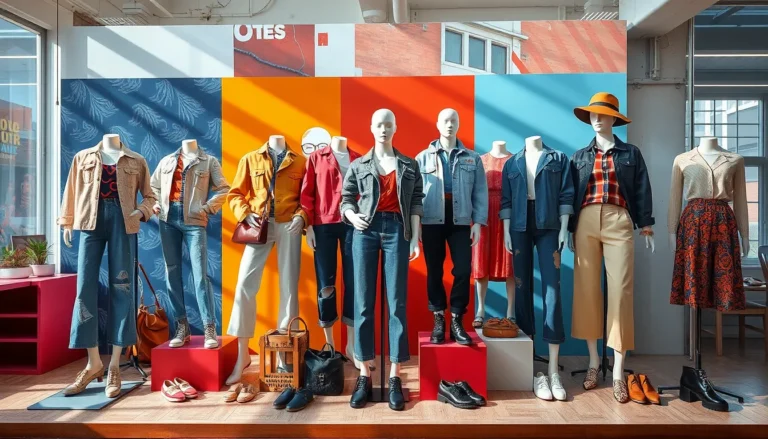Table of Contents
ToggleIn a world overflowing with generic options, personalized design stands out as a beacon of individuality. It transforms ordinary spaces and products into unique reflections of personal taste and lifestyle. From tailored home interiors to customized fashion pieces, the impact of personalized design resonates deeply with those seeking authenticity and connection.
This innovative approach goes beyond aesthetics; it fosters emotional bonds between people and their environments. By prioritizing personal preferences and needs, designers create experiences that truly resonate. As technology advances, the possibilities for personalized design continue to expand, making it more accessible than ever. Whether it’s through 3D printing or bespoke services, the future of design is all about celebrating the unique stories that each individual brings to the table.
Understanding Personalized Design
Personalized design tailors products and environments to individual preferences and needs. It emphasizes uniqueness, creating deeper emotional ties between people and their surroundings.
Definition and Importance
Personalized design refers to the customization of products, services, or spaces to fit personal tastes and requirements. This approach enhances user satisfaction and engagement by considering individual preferences. The importance lies in its ability to turn generic items into meaningful creations, leading to stronger connections with users. According to a study by Deloitte, 1 in 5 consumers are willing to pay more for personalized experiences, highlighting its value in consumer choices.
Key Principles of Personalized Design
- User-Centric Focus: Design processes prioritize the user’s needs and preferences, ensuring the outcome resonates with their identity.
- Emotional Connection: Personalized design fosters emotional bonds through unique expressions that reflect individual stories and lifestyles.
- Adaptability: Personalized products or environments adapt to changing needs, allowing for continuous customization over time.
- Technology Integration: Innovations like 3D printing and AI facilitate personalization, making it easier to create tailored solutions at scale.
- Aesthetic Flexibility: Designs incorporate diverse styles and aesthetics, accommodating a wide range of personal tastes.
Benefits of Personalized Design

Personalized design offers numerous advantages that enhance both user satisfaction and overall interaction with products and spaces. Below are key benefits that underscore its importance in today’s market.
Enhanced User Experience
Enhanced user experience results from tailored designs that meet individual needs. When designs reflect personal preferences, users feel valued and understood. For example, customizable interfaces in apps allow users to adjust features and layouts, resulting in smoother navigation. Research indicates that 80% of consumers prefer personalized experiences, proving that targeted design solutions significantly improve usability and comfort.
Increased Engagement and Retention
Increased engagement and retention stem from personalized design, which makes users more likely to revisit a product or service. When users encounter designs that resonate with their interests, emotional connections strengthen. Data from a study shows that companies implementing personalization strategies see up to 30% greater customer retention. This trend highlights the effectiveness of personalized design in fostering loyalty and encouraging ongoing interaction.
Implementing Personalized Design
Implementing personalized design enhances user engagement and satisfaction by aligning products and spaces with individual preferences. The following subsections explore effective strategies and tools for this approach.
Strategies for Effective Personalization
- User Research: Conducting detailed research on target users identifies their preferences, needs, and behaviors. This information informs design decisions.
- Segmentation: Creating distinct user segments allows for tailored experiences that resonate with specific groups. This increases relevance and connection.
- Feedback Loops: Establishing channels for user feedback fosters continuous improvement and adaptation. Regular updates based on input enhance user satisfaction.
- Customization Options: Offering a range of customizable features empowers users to make meaningful choices. Providing options increases engagement and fosters ownership.
- Iterative Design: Applying an iterative approach to design encourages ongoing enhancements. Regular revisits to design elements refine the alignment with user needs.
Tools and Technologies for Personalization
| Tool/Technology | Description |
|---|---|
| 3D Printing | Enables the creation of bespoke products customized for individual tastes. |
| Customer Relationship Management (CRM) Systems | Collects and analyzes customer data to offer personalized recommendations. |
| Artificial Intelligence (AI) | Powers algorithms that analyze user behavior and preferences for tailored experiences. |
| Virtual and Augmented Reality (VR/AR) | Provides immersive environments for users to visualize personalized designs before implementation. |
| Data Analytics Platforms | Tracks user interactions and preferences, yielding insights to inform design strategies. |
These strategies and technologies drive effective implementation of personalized design, ultimately leading to enhanced user experiences and greater satisfaction.
Challenges in Personalized Design
Personalized design faces several challenges that impact its effectiveness and acceptance. Addressing these challenges is essential for achieving successful implementation.
Data Privacy Concerns
Data privacy remains a critical issue in personalized design. As organizations collect user data to tailor experiences, concerns about data security arise. A survey by Pew Research Center indicates that 79% of consumers worry about how their data is used, impacting their willingness to engage with personalized designs. Regulations like GDPR in Europe and CCPA in California establish strict guidelines, necessitating transparency in data collection practices. Organizations must ensure robust data protection measures, fostering trust while still delivering personalized experiences.
Balancing Personalization and User Control
Striking a balance between personalization and user control is vital. While tailored experiences enhance satisfaction, users may feel overwhelmed if customization options are excessive. Research from Accenture shows that 83% of consumers prefer brands respecting their personal preferences without being intrusive. Designers must implement intuitive systems that allow users to manage their preferences easily. Providing clear options for customization while avoiding information overload promotes user empowerment and enhances the overall experience.
Future Trends in Personalized Design
Emerging trends in personalized design continue to reshape user experiences. The integration of advanced technologies and changing user expectations drives innovation in this field.
AI and Machine Learning Integration
AI and machine learning play pivotal roles in enhancing personalized design. They analyze vast amounts of user data to identify preferences and predict behaviors. Designers leverage algorithms to customize user experiences dynamically. For instance, e-commerce platforms utilize AI to recommend products based on browsing history, increasing user engagement. Machine learning algorithms continually improve these recommendations over time, tailoring suggestions to individual tastes. A study by McKinsey highlights that AI-driven personalization can lead to a 10-15% increase in revenue by directly impacting customer choices.
Evolving User Expectations
User expectations regarding personalized design are evolving rapidly. Consumers increasingly demand experiences that cater to their unique needs. They expect seamless, responsive interactions that reflect their preferences. Research by Salesforce indicates that 70% of consumers say personalized experiences influence their purchasing decisions. Users also seek transparency regarding how their data is collected and utilized. Meeting these expectations requires brands to adopt more transparent practices while providing customizable options. As a response, companies that prioritize user preferences and foster trust will likely see higher loyalty levels.
Personalized design is more than a trend; it’s a powerful way to create meaningful connections between individuals and their environments. By embracing customization, brands can enhance user satisfaction and foster loyalty. As technology continues to evolve, the opportunities for personalization will only expand, allowing for deeper emotional engagements.
However, companies must navigate challenges like data privacy and user control to build trust. Those that succeed in balancing personalization with respect for user preferences will stand out in a crowded marketplace. The future of personalized design looks promising, driven by innovation and a commitment to understanding unique user needs.




